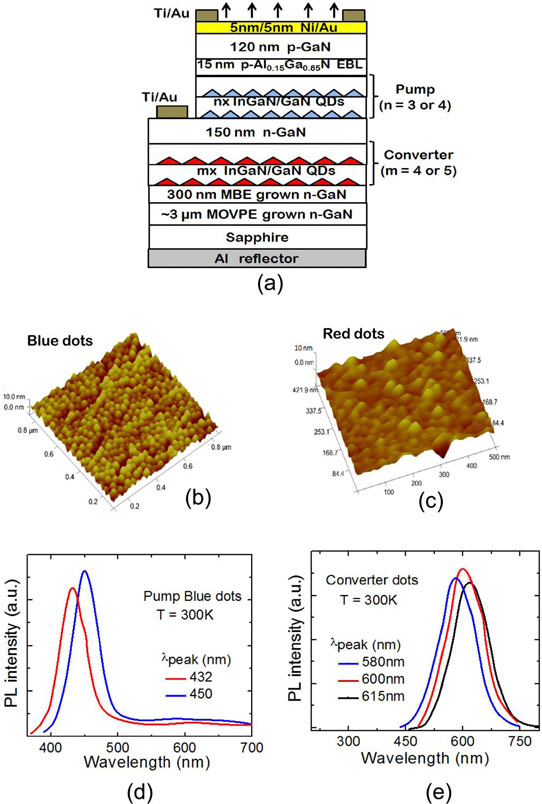- News
10 October 2014
Cool-white quantum dot light-emitting diode
University of Michigan in the USA and OSRAM Opto Semiconductors GmbH in Germany have developed cool-white light-emitting diodes (LEDs) using quantum dot (QD) structures [Shafat Jahangir et al, Appl. Phys. Lett., vol105, p111117, 2014].
The devices consisted of indium gallium nitride (InGaN) QD active pump and convertor regions (Figure 1). The pump region emitted light with a spectral peak in the blue that was converted to longer yellow/orange wavelengths in the convertor region.

Figure 1: (a) Schematic of InGaN/GaN QD wavelength converter white LED heterostructure; atomic force microscopy images of self-organized In0.24Ga0.76N/GaN dots with peak emission at 450nm (b) and In0.37Ga0.63N/GaN dots with peak emission at 600nm (c); room-temperature photoluminescence of blue-emitting pump dots (d); and red-emitting converter dots (e) incorporated in LED heterostructure.
Commercially, white LEDs are mainly based on yellow or more complex phosphors pumped by blue or ultraviolet radiation. However, such devices suffer from power losses while the phosphor materials tend to degrade upon heating.
Quantum well (QW) pump/convertor systems suffer from efficiency problems arising from polarization-induced electric fields that tend to inhibit electron-hole recombination into photons (the quantum-confined Stark effect). QDs form in a strain relaxation process that reduces these polarization-induced fields, improving recombination efficiency into photons. (However, the barrier to carrier injection into QDs is usually higher than for QWs.)
The quantum dot structures were grown by plasma-assisted molecular beam epitaxy (PAMBE) on c-plane GaN on sapphire templates, using a Veeco Gen 930 system. ‘Stranski-Krastanow’ – or layer-plus-island – mode growth results in self-organized InGaN QDs through strain relaxation. Multiple layers of dots were separated by GaN barriers in both the convertor and pump regions. The long-wavelength converter QD stack was grown at 541-550°C with 12nm barriers. The pump stack was grown at 585-592°C with 16nm barriers.
The n-GaN 300nm buffer and 150nm contact layers were grown at 720°C. The p-AlGaN electron-blocking and p-GaN contact layers were grown at 680°C. The researchers optimized the numbers of QD layers and the parameters of the dot formation process with the aims of true white light and efficiency.
The mesa LEDs measured 600μmx600μm. The device incorporated a semi-transparent nickel/gold window on the p-GaN contact layer and an aluminium mirror on the back-side of the substrate. The turn-on voltage was in the range 5.5-6.0V with a series resistance of 20-24Ω.
The devices showed smaller blue-shift with increasing current than planar QW LEDs. The researchers attribute this to smaller polarization fields in QD layers due to the strain relaxation in the growth process, compared with QW layers.
The external quantum efficiency (EQE) peaked in the injection current density range of 37-45A/cm2. The efficiency droop at 100A/cm2 was 14-17%.
The researchers measured Commission Internationale de I’Eclairage (CIE) chromaticity coordinates (X, Y) and correlated color temperatures (CCT) (Table 1). The small blue-shift resulted in a small 210K shift in the CCT of device C from 4375K to 4585K for injection at 25A/cm2 and 100A/cm2, respectively. The researchers say that this is better than for MQW LEDs with MQW convertors. Similar small shifts were found for the other devices.
Table 1: CIE chromaticity coordinates and correlated color temperatures of wavelength converter white LEDs at injection current density of 45A/cm2.
| LED | Pump dot emission wavelength | Converter dot emission wavelength | Chromaticity coordinates (X, Y) | CCT |
| A | 450nm | 580nm | (0.34, 0.38) | 5350K |
| B | 450nm | 600nm | (0.35, 0.37) | 4830K |
| C | 450nm | 615nm | (0.37, 0.35) | 4420K |
| D | 432nm | 580nm | (0.33, 0.36) | 5790K |
| E | 432nm | 580nm | (0.32, 0.32) | 6700K |
Cool white corresponds to 4500K and warm/soft white to 3000K. The researchers comment: “These values of CCT would be difficult to achieve with all-quantum-well converter LEDs, since long-wavelength ([more than] 600nm) emission with high radiative efficiency is difficult to achieve with such InGaN/GaN quantum wells due to increasing material inhomogeneities and a strong polarization field.”
QW- or phosphor-based color conversion results in higher CCTs above 5500K. The researchers believe that “InGaN/GaN quantum dot converter LEDs may prove to be crucial for the realization of cool-white and warm-white light sources.”
Cool-white quantum dot LED LEDs InGaN InGaN QDs GaN PAMBE
http://dx.doi.org/10.1063/1.4896304
The author Mike Cooke is a freelance technology journalist who has worked in the semiconductor and advanced technology sectors since 1997.


